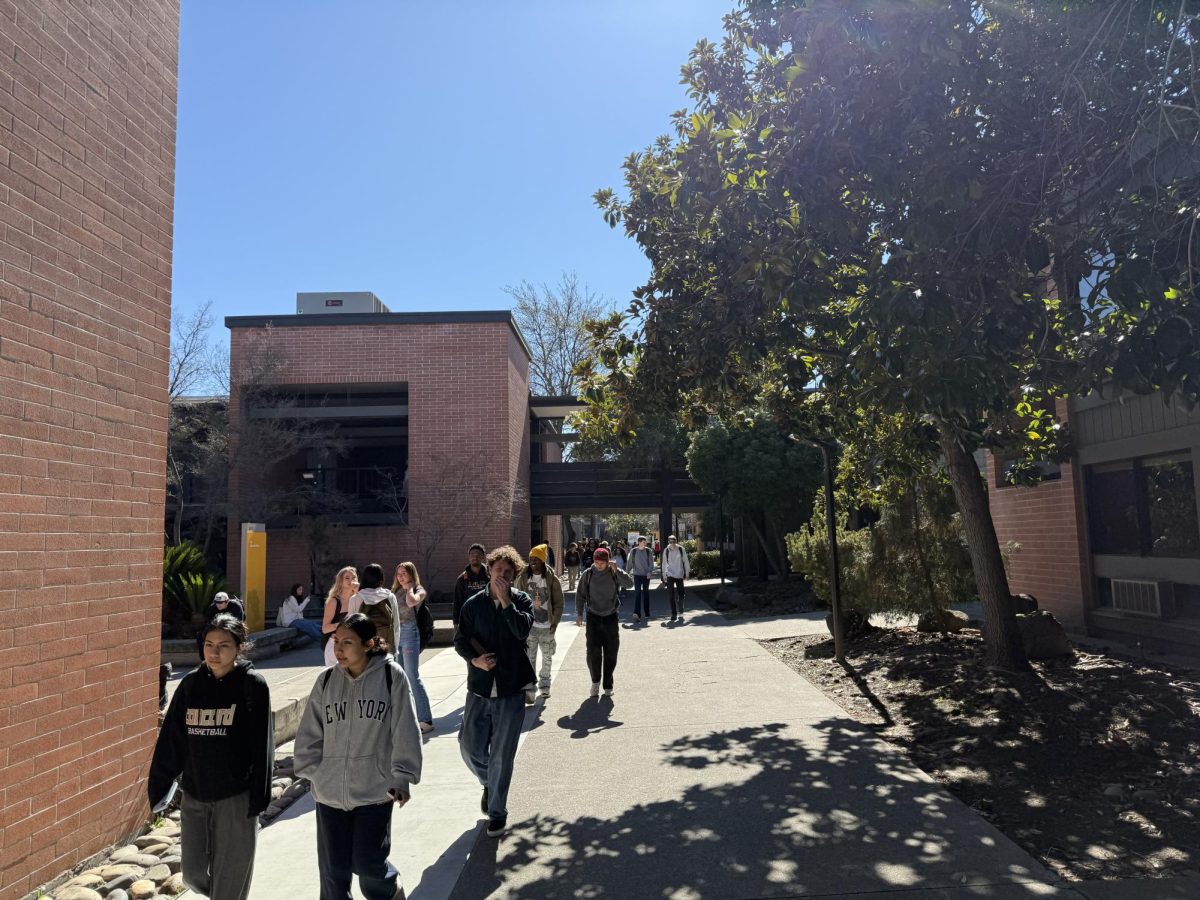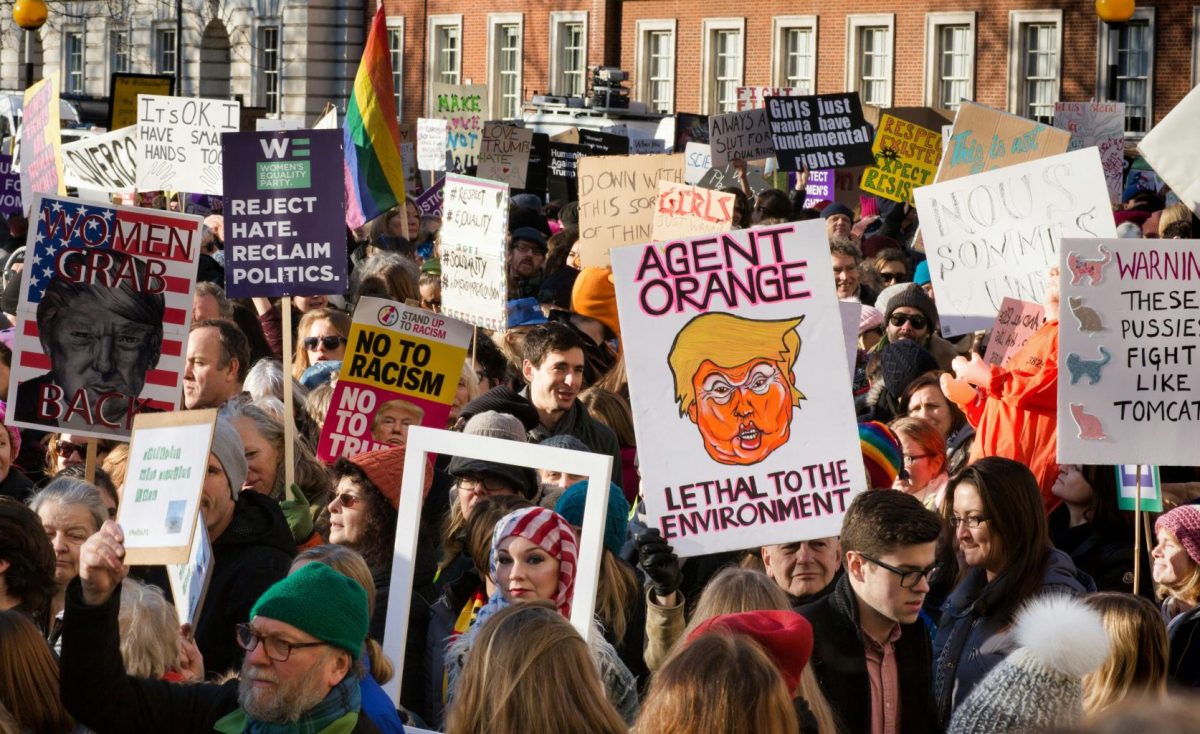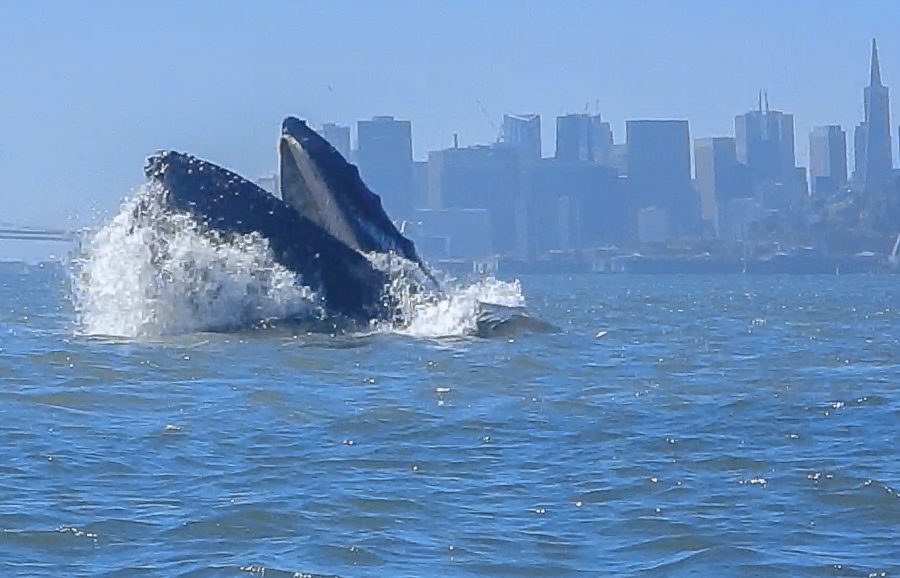Humpbacks feeding in Bay sign of complex environmental shifts
Food chains on the move as ocean temperatures change
A humpback whale lunge-feeds in San Francisco Bay, July 10, 2016
September 28, 2016
Sunlight glittered on the Bay as Berkeley resident Lyrinda Snyderman and her friends paddled their kayaks to Angel Island on a calm, clear July morning. The breeze was light and salty. Circling seabirds shrieked and dove above the tideline near Treasure Island.
Snyderman noticed odd, dark triangles bobbing for a moment beneath the whirling birds, then vanishing from sight. Tug boats, she thought.
Then one of her friends yelled, “I think I see whales.”
Snyderman quickly flipped her camera to zoom. For the next 50 minutes, she and her friends had a front row seat to the remarkable spectacle of humpback whales lunge-feeding in the San Francisco Bay.
The unprecedented appearance of healthy humpbacks feeding in the Bay is a sign of complex shifts in climate and ocean ecology, marine biologist believe. Changes in atmospheric conditions and water temperature, along with water quality, ultimately effect where sea life lives and thrives.
“We tend to focus on the megafauna because we can see them, but it’s important to focus on the little things, too,” says Dr. Jonathan Stern, a marine biologist with San Francisco State University. “There have been these huge schools of anchovies right off shore…and as the tides move in and out of San Francisco Bay, so do the anchovies.”
The humpbacks, in turn, follow their favorite food into the Bay.
Up until this year, Stern says, there were “plenty of food resources for them further offshore, out towards the Farallon Islands.”
Dr. Ellen Hines, associate director of The Romberg Tiburon Research Center, says colder, oxygen- and nutrient-rich waters from deeper in the ocean is where the food chains thrive.
In a process called upwelling, the deeper, colder waters rise as Northerly winds along the California coast move warmer surface water away from the shore, she says.
“More food chains are enabled because in this colder upwelling of water… there’s more life.” Hines adds, “The upwelling used to be relatively seasonal and predictive.”
However, a persistent ridge of high pressure parked over the North Pacific and North America several years ago. This high pressure ridge is thought to have contributed to the rise of a large mass of warmer than normal surface ocean temperature.
“The theory is that the upwelling is closer and closer to shore, restricted by this higher ocean temperature. So what is happening is that these animals are coming closer and closer to shore in search of food in the colder, more nutrient-rich waters,” says Hines.
“As more animals come closer to shore, they’re in danger of ship collisions and…crab traps, which are what they really get entangled in.”
The Greater Farallons Marine Sanctuary estimates between 7,500 and 9,000 large ships transit the Golden Gate each year and the shipping channels cut right through marine habitats.
There is evidence that low-frequency noise from ships can be a stressor to whales, Dr. Maya Yamato, a Diablo Valley College marine biologist says. Research shows that whales in the Northern Hemisphere have changed the frequency at which they communicate over the last thirty years. This could possibly be an adaptation to the constant din of ships in their habitat.
Fortunately, there are glimmers of progress in the protection of marine life and their habitats, and improvement in Bay water quality.
Marine biologist Dr. Jonathan Stern says, “Around the year 2000, the Bay started to become cleaner and more productive” thanks to decades of conservation legislation beginning to pay off.
“In 2008, I followed a large school of porpoises inside the Bay, mothers and calves just cavorting around, and that was really surprising,” says Stern.
“Now, we see porpoises in the Bay every day. They actually come in with the tides and go out with the outgoing tides” following the small fish they feed on. As many as 700 individual harbor porpoises have made their way into the Bay, Stern says, many of whom make their homes around the Farallon Islands. Great White Sharks are also now regular guests inside the Gate.
When the humpbacks hung out in the Golden Gate straits this Summer, Stern said he observed ships coming to nearly a complete stop to allow the whales wide berth. Because of the number of animals, that was a lot of rerouting.
“I would go out at the Marin Headlands between the Golden Gate and Land’s End. We would see 40 humpbacks at a time…spread out in groups just lunge feeding and this was for weeks at a time,” Stern says.
It’s good to know that even if marine mammals are taken off the Endangered Species List, they’re still protected by the Marine Mammals Protection Act (MMPA), he says.
Mary Jane Schramm of The Greater Farallons Marine Sanctuary says the MMPA recommends whale watchers stay at least 300 ft. away. This includes windsurfers, kite boarders and boaters and is for the public’s safety as well as the whale’s.
“Stress from multiple non-lethal disturbances is also harmful, as (the whales) could be ‘spooked’ into heading…up the Sacramento River… There, death awaits if they don’t get back to the ocean,” Shramm says.
When recalling her experience kayaking near the humpbacks, Lyrinda Snyderman says, “To be in a small boat next to a whale, you really are sharing that environment with them.
“It was a privilege to be allowed into their lives.”













































































